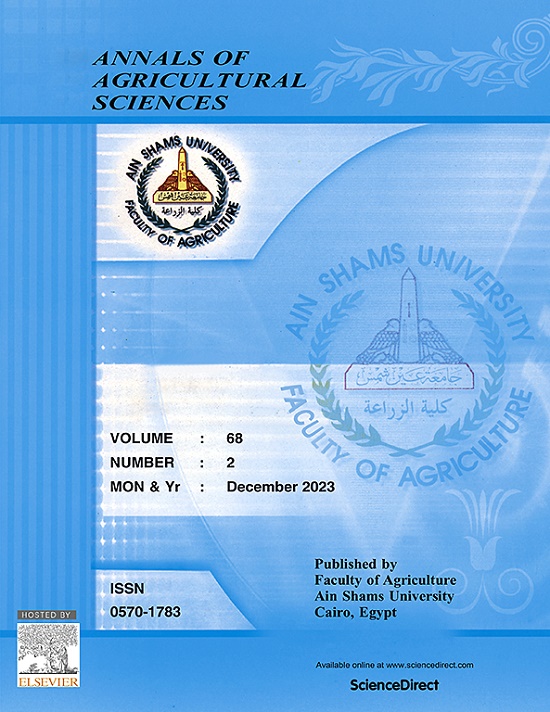Assessing heavy metal bioaccumulation in radish and soil under wastewater and canal water irrigation
IF 3.2
2区 农林科学
Q1 AGRICULTURE, MULTIDISCIPLINARY
引用次数: 0
Abstract
Freshwater resources are continuously depleting over time due to the combination of various climatic, political and anthropogenic factors. The freshwater shortage has compelled farmers to use sewage water as an irrigation source for vegetable cultivation. However, urban sewage water contains a sufficient amount of heavy metals which can easily damage soil, crops and affect human health. The present study compared the concentrations of toxic metals including copper (Cu), iron (Fe), zinc (Zn), manganese (Mn), cadmium (Cd) lead, (Pb) and cobalt (Co) in radish and soil irrigated with sewage water (SW) versus canal water (CW). The results showed that the SW contains a significant number of heavy metals e.g., Cu (1.735 mg/kg), Fe (3.775 mg/kg), Zn (1.885 mg/kg), Mn (0.375 mg/kg), Cd (0.044 mg/kg), Co (0.05 mg/kg), Pb (0.062 mg/kg), and Mo (0.07 mg/kg), leading to increase the accumulation in the radish and soil by increasing their permissible limits. The irrigation water sources also have the potential to affect soil physicochemical properties and proximate composition of the radish. The sewage water irrigation notably increased salinity, nutrients, and soil organic matter, however it also increased the contamination risks. The Pollution Load Index (PLI) and Bio-concentration Factor (BCF) metrics revealed that sewage water has substantial adverse health impacts due to high metal contamination. There is an urgent need to adopt the innovative management strategies to improve the irrigation water sources to prevent soil health threats from metal pollution.
废水和渠水灌溉条件下萝卜和土壤重金属生物积累的评价
随着时间的推移,由于各种气候、政治和人为因素的综合作用,淡水资源正在不断枯竭。淡水短缺迫使农民使用污水作为蔬菜种植的灌溉水源。然而,城市污水中含有大量重金属,容易对土壤、作物造成破坏,影响人体健康。本研究比较了污水(SW)和运河水(CW)灌溉萝卜和土壤中铜(Cu)、铁(Fe)、锌(Zn)、锰(Mn)、镉(Cd)、铅(Pb)和钴(Co)等有毒金属的浓度。结果表明:萝卜萝卜中重金属Cu (1.735 mg/kg)、Fe (3.775 mg/kg)、Zn (1.885 mg/kg)、Mn (0.375 mg/kg)、Cd (0.044 mg/kg)、Co (0.05 mg/kg)、Pb (0.062 mg/kg)、Mo (0.07 mg/kg)含量显著增加,通过提高萝卜萝卜和土壤中重金属的允许限量而增加了萝卜萝卜和土壤中重金属的积累。灌溉水源也有可能影响土壤理化性质和萝卜的近似组成。污水灌溉显著增加了土壤盐分、养分和有机质,但也增加了污染风险。污染负荷指数(PLI)和生物浓度因子(BCF)指标显示,由于高金属污染,污水对健康有重大不利影响。为了防止金属污染对土壤健康的威胁,迫切需要采用创新的管理策略来改善灌溉水源。
本文章由计算机程序翻译,如有差异,请以英文原文为准。
求助全文
约1分钟内获得全文
求助全文
来源期刊

Annals of Agricultural Science
AGRICULTURE, MULTIDISCIPLINARY-
CiteScore
12.60
自引率
0.00%
发文量
18
审稿时长
33 days
期刊介绍:
Annals of Agricultural Sciences (AOAS) is the official journal of Faculty of Agriculture, Ain Shams University. AOAS is an open access peer-reviewed journal publishing original research articles and review articles on experimental and modelling research at laboratory, field, farm, landscape, and industrial levels. AOAS aims to maximize the quality of the agricultural sector across the globe with emphasis on the Arabian countries by focusing on publishing the high-quality applicable researches, in addition to the new methods and frontiers leading to maximizing the quality and quantity of both plant and animal yield and final products.
 求助内容:
求助内容: 应助结果提醒方式:
应助结果提醒方式:


